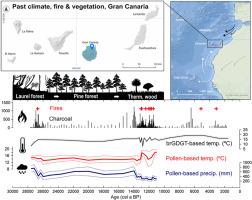28 cal ka BP以来大加那利岛千年尺度气候变率和火情及其对植被的影响
IF 3.3
1区 地球科学
Q1 GEOGRAPHY, PHYSICAL
引用次数: 0
摘要
气候变化和火灾制度在千年尺度上对加那利群岛植被的影响在很大程度上仍然未知。这项研究展示了群岛上最长的连续古生态记录,从大加那利岛的Vega de Arucas开始,跨越了28,000年。使用多代理方法,我们分析了木炭颗粒的火灾频率重建,化石花粉和非花粉孢型(NPPs)的植被变化,沉积学的沉积物质变化,支链甘油二烷基甘油四醚(brGDGTs)的空气温度,以及花粉气候模型的温度,降水和相对湿度估计。我们记录了与区域和全球气候变化相关的植被和火灾制度的不同变化。在末次盛冰期(LGM)之前,花粉和木炭数据表明,在低海拔地区(海拔200-300米)存在月桂林分类群(如Morella faya),很少发生火灾,表明环境更潮湿,温度更低。在LGM期间,月桂林被干燥的松林所取代,这表明温度比以前低,水的可用性也减少了。从月桂林到松林的转变与火灾频率的增加相吻合。在末次冰期(b ølling- allero ød和Younger Dryas),从松林迅速转变为喜热林地(如Juniperus sp., Phoenix canariensis),反映了气候持续振荡和火灾活动更频繁的温暖条件。尽管在全新世期间花粉保存较差,阻碍了当前对这一时期植被变化的理解,但木炭记录表明频繁发生火灾。虽然以前的观点提出,由于海洋的调节作用,岛屿可能受到气候变化的缓冲,但我们的研究证实了全球和区域气候变化对当地植被分布和火灾制度的直接影响。这对于理解面对未来气候变化的植被恢复力和景观管理具有重要意义。本文章由计算机程序翻译,如有差异,请以英文原文为准。

Millennial-scale climatic variability and fire regimes and their impacts on vegetation in Gran Canaria since since 28 cal ka BP
The influence of climate change and fire regimes on vegetation in the Canary Islands at the millennial scale remains largely unknown. This study presents the longest continuous palaeoecological record from the archipelago, spanning the last 28,000 years from Vega de Arucas in Gran Canaria. Using a multiproxy approach, we analysed charcoal particles for fire frequency reconstruction, fossil pollen and non-pollen palynomorphs (NPPs) for vegetation change, sedimentology for changes in material deposited, branched glycerol dialkyl glycerol tetraethers (brGDGTs) for air temperature, and pollen climate modelling for temperature, precipitation, and relative humidity estimates. We document different changes in vegetation and fire regimes linked to regional and global climatic transitions. Before the Last Glacial Maximum (LGM), pollen and charcoal data indicate local presence of a laurel forest taxa (e.g., Morella faya) at low elevations (c. 200–300 m above sea level), subjected to infrequent fires, suggesting wetter conditions and cooler temperatures. During the LGM, the laurel forest was replaced by a dry pine forest, indicative of lower than previous temperatures and reduced water availability. This transition from laurel to pine forest coincides with an increase in fire frequency. During the last deglaciation (Bølling-Allerød and Younger Dryas), a rapid shift occurred from pine forest to thermophilous woodland (e.g., Juniperus sp., Phoenix canariensis), reflecting warmer conditions with continued climate oscillations and more frequent fire activity. Although pollen preservation was poor during the Holocene and hampers current understanding of vegetation changes throughout this period, charcoal records indicate frequent fires. While previous views have proposed that islands may have been buffered from climatic changes due to the regulating influence of the ocean, our study confirms a scenario of direct influence of global and regional climatic variations in local vegetation distribution and fire regimes. This has important implications for understanding vegetation resilience and landscape management in the face of future climatic changes.
求助全文
通过发布文献求助,成功后即可免费获取论文全文。
去求助
来源期刊

Quaternary Science Reviews
地学-地球科学综合
CiteScore
7.50
自引率
15.00%
发文量
388
审稿时长
3 months
期刊介绍:
Quaternary Science Reviews caters for all aspects of Quaternary science, and includes, for example, geology, geomorphology, geography, archaeology, soil science, palaeobotany, palaeontology, palaeoclimatology and the full range of applicable dating methods. The dividing line between what constitutes the review paper and one which contains new original data is not easy to establish, so QSR also publishes papers with new data especially if these perform a review function. All the Quaternary sciences are changing rapidly and subject to re-evaluation as the pace of discovery quickens; thus the diverse but comprehensive role of Quaternary Science Reviews keeps readers abreast of the wider issues relating to new developments in the field.
 求助内容:
求助内容: 应助结果提醒方式:
应助结果提醒方式:


